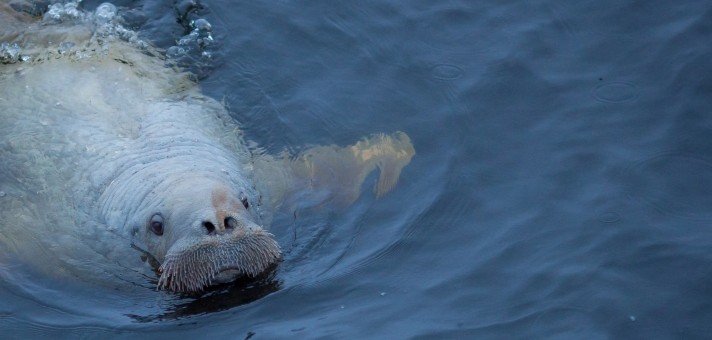Head of the laboratory Ph.D. (Biology) Elena I. Druzhkova
BRIEF HISTORY
Research into planktology began at the Murmansk Biological Station in the late 1930s. In 1952, the Laboratory of plankton was officially established as independent structural unit. Over the entire period of its functioning, the range of tasks has steadily increased. To date, observations cover all components of marine pelagic ecosystems including nanoplankton, bacteria and viruses above traditional mikrofito- and zooplankton. The Laboratory conducts measurements of hydrochemical parameters, the content of photosynthetic pigments and production indices. Areas of research were expanded: in addition to the Barents Sea, work is being done through all seasons on the entire Arctic basin, the White and Kara Seas, the Laptev Sea and the Norwegian, Greenland and Azov Seas.
In recent years, the use of up-to-date materials and equipment, the electron microscopy in particular, allows conducting research on a qualitatively new level. It is possible to detect previously not considered most abundant representatives of the pelagic sea - viroplankton organisms significantly impacting on the ecosystem structure and production processes in the ecosystem.

THE RESEARCH GUIDELINES ARE:
- seasonal dynamics of plankton communities and environmental factors impact;
- productivity of pelagic ecosystems and factors determining it;
- features of biotic relations in pelagic communities, the role of bacteria and viruses;
- structure and functioning of ecosystems in estuarine areas: Kola and Yenisei Bays, Ob and Taz Bays, the Gulf of Taganrog;
- features of the production processes in pelagic coastal waters of the Arctic archipelagos: Spitsbergen, Novaya Zemlya, Franz Josef Land.

THE BASIC FINDINGS ARE:
- According to figures of long-term research an ecological-geographical summary report of plankton fauna diversity was made up for the entire Barents Sea. 412 species and 10 taxa of higher rank were registered: 74% are referred to the true pelagic zooplankton organisms, holoplankton dominates in the number of species (57%) as well as the aquatic organism of medium size (54%); omnivorous species form the basis of the plankton fauna accounting 77%. The highest taxonomic richness is typical of the southern part of the sea where 75% of the total number of zooplankton are met. It was found out that the generative strategy of common Arctic zooplankton species in waters of different origins depends on their nutritional adaptation.
- Based on the morphometric analysis the presence of hybrid populations of common species of copepods Calanus. finmarchicus and C. glacialis was revealed in areas of their co-location.
- For the first time a compiled summary report of biogeographic, ecological and taxonomic diversity in major groups of marine phytoplankton - diatoms and dinophytes – was made up for waters of Russian Arctic seas: the White, Barents, Kara, Laptev, East Siberian and Chukchee Seas. Representatives of 649 diatoms species were observed, dinophytes are represented by 283 species of microalgae; Navicula (Pennatophyceae) and Chaetoceros (Centrophyceae) predominate containing 87 and 50 species respectively, dinoflagellates of Protoperidinium have 58 representatives.
- An inventory of the taxonomic composition of planktonic algae in the area of Franz Josef Land Archipelago and adjacent waters was taken. We compiled an annotated taxonomic list, numbering 189 microalgae species belonging to 8 divisions, and calculated a production capacity of FJL waters. It allowed us to evaluate the contribution of coastal archipelago waters to the production potential of the Barents Sea.
- For the first time for phytoplankton communities of the Ob -Yenisei shallow waters of the Kara Sea we have formulated a conceptual scheme of the annual succession cycle counting 5 phases: early spring (cryoflora blooming); spring (near-edge blooming); a phase of balanced development; autumn; winter phase (dormancy phase).
- We estimated a contribution of different ecological groups of algae (phytoplankton, сryoflora, micro- and macrophytobenthos) in to the annual primary production in the Barents Sea and its definite habitats (benthal, littoral, sublittoral and pelagic zones). We showed that in coastal ecosystems about a half of the annual primary product is formed in bottom biocenoses. It was found out that the factor of the ice coverage does not restrict the implementation of primary production potential of marine pelagic ecosystems of the Western Arctic Shelf.
- It was revealed that while the eutrophication of the Arctic estuarine water bodies in the pelagian algocenoses against the background of conservation of the basic succession cycle structure an increase of mass forms occurs at the expense of the development of definite previously small-numbered microalgae species.
Plankton laboratory employees
Druzhkova Elena Ivanovna e-mail
Bardan Sergey Ivanovich
Larionov Victor Vital`evich
Dvoretckiy Vladimir Gennad`evich
Vodop`ianova Veronika Vladimirovna
Shirokolobova Tat`iana Ivanovna
Ishkulova Tat`iana Gennad`evna
Olei`nik Anatolii` Anatol`evich
Berchenko Igor` Vasil`evich
Shirokolobov Dmitrii` Vladimirovich





